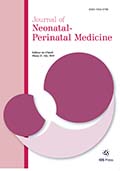Authors: Dianova, E. | Fogel, J. | Verma, R.P.
Article Type:
Research Article
Abstract:
BACKGROUND: The aim was to assess the predictability of transcutaneous bilirubinometry in late preterm and term neonates at risk for pathological hyperbilirubinemia, and to identify the neonatal population in which transcutaneous bilirubin most accurately predicts serum bilirubin level (SB, mg/dl). METHODS: The correlations between transcutaneous bilirubin (TCB, mg/dl) and SB in different neonatal population subsets; and between Δ TSB (TCB-SB) and relevant neonatal variables and clinical groups were analyzed. RESULTS: TCB correlated with SB (r = 0.82, p < 0.05) in the cohort (n = 350) and in population subsets (r = 0.81–0.9, p < 0.001). Black infants with gestational age
…(GA) >35 weeks and chronological age (CA) >3 days recorded strongest correlation (r = 0.9, p < 0.001) followed by Blacks, and non-Black infants with CA >3 days and GA >35 weeks. Δ TSB was positive in Blacks, and in infants with CA <3 days, or with no phototherapy. Δ TSB was negative in non-Blacks, in infants with positive direct Coombs test (DC+) or those receiving phototherapy. Black race [beta (SE) = 1.3(0.33), p < 0.001] had positive, while CA [beta (SE) =−1.74 (0.36), p < 0.001], DC + status [beta (SE) =−0.72 (0.25), p = 0.004] and receipt of phototherapy [beta (SE) =−0.84 (0.21), p < 0.001] each had negative correlation with Δ TSB. Δ TSB for Blacks was >Whites, Hispanics and Asians. CONCLUSION: SB is best predicted by TCB in Black infants with CA over 3 days and GA over 35 weeks. Variability in SB estimation by TCB is race, CA and immune mediated hemolysis specific.
Show more
Keywords: Transcutaneous bilirubinometry, transcutaneous bilirubin, serum bilirubin, neonatal hyperbilirubinemia, predictability, black race, immune mediated hemolysis, gestational age, chronological age
DOI: 10.3233/NPM-200486
Citation: Journal of Neonatal-Perinatal Medicine,
vol. 14, no. 2, pp. 261-267, 2021
Price: EUR 27.50





